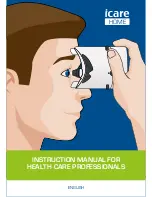
EN3
Important Safety Information
Read the Important Safety Information in this instruction manual before
using this device.
Follow this instruction manual thoroughly for your safety. Keep for future reference. For
specific information about patient’s symptoms, CONSULT WITH A PHYSICIAN.
WARNING
Indicates a potentially hazardous situation which, if not
avoided, could result in death or serious injury.
• NEVER diagnose or treat a patient based only on the result from this device. ONLY a
physician is qualified to diagnose and treat patient’s respiratory disease.
• This device is intended for use on a patient whose illness was diagnosed as bronchitis,
bronchiolitis or bronchial asthma.
• Consult with a physician to discuss the results of the measurement with this device.
• If a patient is having signs and symptoms of chest tightness, shortness of breath,
coughing or wheezing, a wheeze may not be detected because:
- the breathing sound is too loud or too soft;
- the wheeze is at extremely small amplitude, extremely short duration, extremely
high frequency or extremely low frequency;
- an asthma attack occurs without wheezing.
Always take action as prescribed by a physician, no matter what the result from this
device is.
This device also may incorrectly detect any noise as a wheeze because various sounds
are occurring in patient’s body such as:
- voice or cry of a patient;
- nasal obstruction sound;
- sputum sound etc.
• DO NOT use in case of severe asthma attack or respiratory failure. Consult with a
physician immediately.
• Take a measurement again if you are concerned about the result. This device can detect
wheeze only while taking a measurement. Wheeze can occur after taking a measurement.
If you are still concerned after taking a measurement again, consult with a physician.
• DO NOT use this device on a chest that is injured or that is under medical treatment.





































